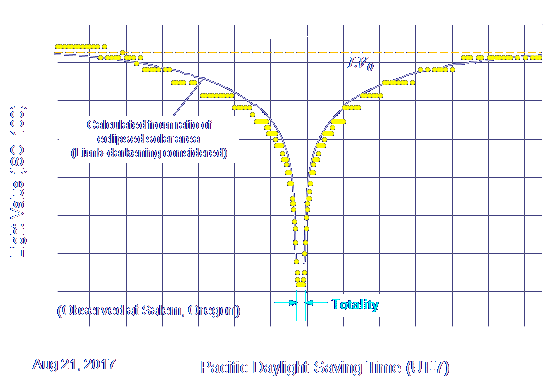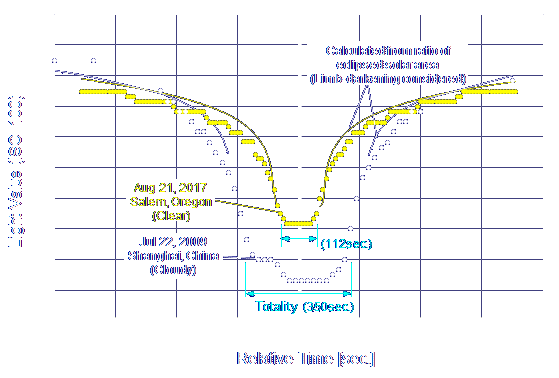Change of sky brightness during Total Solar Eclipse (Aug 21, 2017)
| Date & Time: | Aug 21 2017 PDT(-0700) |
| Program mode (spot integral) |
| Optical: | SIGMA f=4.5mm EX Circular DC |
| Fixed on tripod |
| Digital Camera: | Nikon D50 (Remodeled) |
| Location: | Salem, Oregon, USA |
| Camera Settings: | Recording format...12bit CCD-RAW, converted to 16bit TIFF (3008×2000) |
| CCD Sensitivity...ISO200, White-Balance...Manual |
 Change of sky brightness during Total Solar Eclipse
Change of sky brightness during Total Solar Eclipse
Individual numbers correspond to those in upper image.
A white curve indicates calculated LV under an assumption that the illuminance is proportion
to the area ratio of uneclipsed solar area with the limb-darkening effect
(Assumed the LV of normal midday sky, LV0, as 14.5).
This multi-flame picture has captured change of sky brightness in progress of the total solar eclipse on Aug 21, 2017 with an SLR digital still camera and whole-sky photo lens in program mode.
Individual images have been adjusted their brightness in proportion to the Light-Values (LVs) to record sky of zenith with definite photographic density.
A figure indicates the change of LVs converted at ISO100 with an interval of a minute, ten seconds before and after ten minutes of the totality.
For reference, the figure also shows the calculated LVs with a white solid curve under an assumption that the sky illuminance is proportion to the area ratio of uneclipsed solar area.
The calculation has considered the limb-darkening effect of the sun, it can be seen that the calculated LV can represent the measured ones within 0.5 LV in error.
You can confirm that LV was down 13 steps during the totality, estimated the brightness (illuminance) of sky was approximately 1/8000 (=1/213) of that in normal midday.
The brightness is equivalent to that in twilight. I could detect the Venus near the zenith clearly and the bright situation in lower surrounding skies only for two minutes.
Comparison with a total solar eclipse on Jul 22, 2009 in Shanghai, China
 Comparison of sky brightness during two Total Solar Eclipses
Comparison of sky brightness during two Total Solar Eclipses
White...On Jul 22, 2009 (Shanghai, cloudy), Yellow...On Aug 21, 2017 (Salem, mostly sunny)
Solid curves indicate calculated LVs under an assumption that the illuminance is proportion
to the area ratio of uneclipsed solar area with the limb-darkening effect
Comparison of two cases of total solar eclipse
| Date / Location | Jul 22, 2009 / Shanghai | Aug 21, 2017 / Salem |
| Saros series | 136 | 145 |
| Totality time | 5min. 50sec. | 1min. 52sec. |
| Width of umbra | 250 km | 140 km |
| Weather | Cloudy | Clear |
Equipment for
measurement | Nikon D50 &
15mm fish-eye | Nikon D50 &
4.5mm whole-sky |
| Photometric | Spot integral | Spot integral |
Min. LV / illuminance
(LV 0=2.5 Lux) | -1.33 / 1.0 Lux | +2.35 / 12.7 Lux |
| Criterion | Night with full moon | Civil twilight |
An upper figure shows the comparison of time change of sky brightness between two cases of total solar eclipse of this time and clouded one we observed on Jul 22, 2009 at Shanghai, China.
Horizontal axis has indicated the time relative to the maximum eclipsed times.
Those two eclipses have a different of over three times in the totality, we can recognize that there is great difference in sky illuminances.
The difference of LVs in maximum eclipse of two cases has approximately 3.7 steps, equivalent to 13 times in illuminance.
It's conceivable that the difference of amount of leakage light from outside of the lunar umbra made the result because those eclipses have the different of a bit smaller than two times in width of total eclipse band.
The sky's illuminance in maximum eclipse in 2009 (1.0 Lux) is almost equal to that of night with the full moon.
On the contrary a case in 2017 (12.7 Lux) has mostly the same with that of the twilight just after sunset (civil twilight).
|



